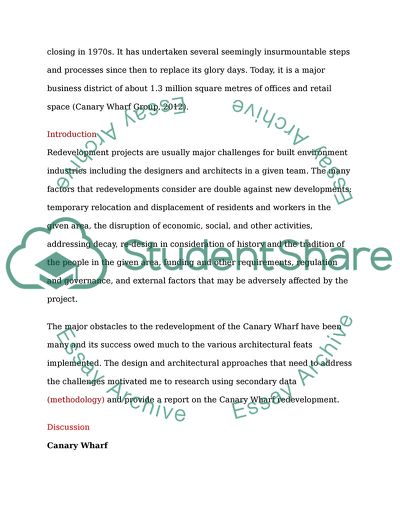Cite this document
(Sustainable Practices in the Redevelopment of Canary Wharf Case Study Example | Topics and Well Written Essays - 2500 words, n.d.)
Sustainable Practices in the Redevelopment of Canary Wharf Case Study Example | Topics and Well Written Essays - 2500 words. https://studentshare.org/architecture/1766256-why-you-want-to-become-a-professional-architect-and-carry-out-further-research-on-the-topic-inspriration-from-a-major-development-porject-sustainabilityhow-successful-has-it-actually-been-did-local-people-benefit-or-were-they-displaced-by-outsiders
Sustainable Practices in the Redevelopment of Canary Wharf Case Study Example | Topics and Well Written Essays - 2500 words. https://studentshare.org/architecture/1766256-why-you-want-to-become-a-professional-architect-and-carry-out-further-research-on-the-topic-inspriration-from-a-major-development-porject-sustainabilityhow-successful-has-it-actually-been-did-local-people-benefit-or-were-they-displaced-by-outsiders
(Sustainable Practices in the Redevelopment of Canary Wharf Case Study Example | Topics and Well Written Essays - 2500 Words)
Sustainable Practices in the Redevelopment of Canary Wharf Case Study Example | Topics and Well Written Essays - 2500 Words. https://studentshare.org/architecture/1766256-why-you-want-to-become-a-professional-architect-and-carry-out-further-research-on-the-topic-inspriration-from-a-major-development-porject-sustainabilityhow-successful-has-it-actually-been-did-local-people-benefit-or-were-they-displaced-by-outsiders.
Sustainable Practices in the Redevelopment of Canary Wharf Case Study Example | Topics and Well Written Essays - 2500 Words. https://studentshare.org/architecture/1766256-why-you-want-to-become-a-professional-architect-and-carry-out-further-research-on-the-topic-inspriration-from-a-major-development-porject-sustainabilityhow-successful-has-it-actually-been-did-local-people-benefit-or-were-they-displaced-by-outsiders.
“Sustainable Practices in the Redevelopment of Canary Wharf Case Study Example | Topics and Well Written Essays - 2500 Words”. https://studentshare.org/architecture/1766256-why-you-want-to-become-a-professional-architect-and-carry-out-further-research-on-the-topic-inspriration-from-a-major-development-porject-sustainabilityhow-successful-has-it-actually-been-did-local-people-benefit-or-were-they-displaced-by-outsiders.


